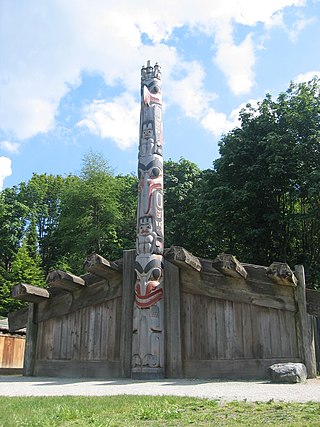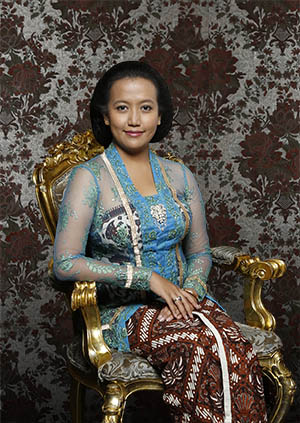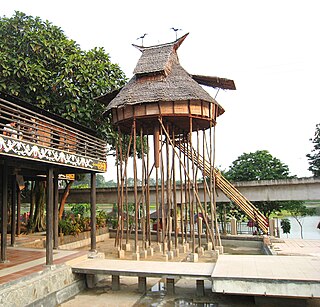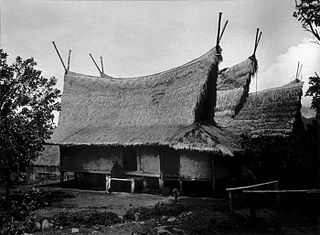
Malays are an Austronesian ethnoreligious group native to eastern Sumatra, the Malay Peninsula and coastal Borneo, as well as the smaller islands that lie between these locations. These locations are today part of the countries of Malaysia, Indonesia, the southern part of Thailand, Singapore and Brunei Darussalam.

A longhouse or long house is a type of long, proportionately narrow, single-room building for communal dwelling. It has been built in various parts of the world including Asia, Europe, and North America.

The National Museum is in Jalan Damansara, in Kuala Lumpur, Malaysia. The museum is close to Perdana Lake Gardens and it provides an overview of Malaysian history and culture. Its façade comprises elements from both traditional Malay and modern features. It was inaugurated on 31 August 1963, and it serves as a repository of Malaysia's cultural and historical heritage.

The Culture of Malaysia draws on the varied cultures of the different people of Malaysia. The first people to live in the area were indigenous tribes that still remain; they were followed by the Malays, who moved there from mainland Asia in ancient times. Chinese and Indian cultural influences made their mark when trade began with those countries, and increased with immigration to Malaysia. Other cultures that heavily influenced that of Malaysia include Persian, Arabic and British. The many different ethnicities that currently exist in Malaysia have their own unique and distinctive cultural identities, with some crossover.

Malay houses refer to the vernacular dwellings of the Malays, an ethno-linguistic group inhabiting Sumatra, coastal Borneo and the Malay Peninsula.

The traditional Thai house is a loose collection of vernacular architectural styles employed throughout the different regions of Thailand. Thai houses usually feature a bamboo or wooden structure, raised on stilts and topped with a steep gabled roof. The houses from each of Thailand's regions have distinctive styles, which reflect the people's living style, including social and cultural beliefs or religious customs and occupations.

The architecture of Singapore displays a range of influences and styles from different places and periods. These range from the eclectic styles and hybrid forms of the colonial period to the tendency of more contemporary architecture to incorporate trends from around the world. In both aesthetic and technological terms, Singapore architecture may be divided into the more traditional pre-World War II colonial period, and the largely modern post-war and post-colonial period.

A kebaya is an upper garment traditionally worn by women in Southeast Asia, notably in Brunei, Indonesia, Malaysia, Singapore, and Southern Thailand. It is also worn in parts of southern Philippines and Cambodia.

The bahay kubo, kubo, or payag is a type of stilt house indigenous to the Philippines. It often serves as an icon of Philippine culture. The house is exclusive to the lowland population of unified Spanish conquered territories. Its design heavily influenced the Spanish colonial-era bahay na bato architecture.

The architecture of Penang reflects the 171 years of British presence on the island, coalescing with local, Chinese, Indian, Islamic and other elements to create a unique and distinctive brand of architecture. Along with Malacca, Penang is an architectural gem of Malaysia and Southeast Asia. Unlike Singapore, also a Straits Settlement, where many heritage buildings had to make way for modern skyscrapers and high-rise apartments due to rapid development and acute land scarcity, Penang's architectural heritage has enjoyed a better fate. Penang has one of the largest collections of pre-war buildings in Southeast Asia. This is for the most part due to the Rent Control Act which froze house rental prices for decades, making redevelopment unprofitable. With the repeal of this act in 2000 however, property prices skyrocketed and development has begun to encroach upon these buildings, many of which are in a regrettable state of disrepair. The government in recent years has allocated more funding to finance the restoration of a number of derelict heritage buildings, most notably Suffolk House, City Hall and historic buildings in the old commercial district.

The architecture of Indonesia reflects the diversity of cultural, historical, and geographic influences that have shaped Indonesia as a whole. Invaders, colonizers, missionaries, merchants, and traders brought cultural changes that had a profound effect on building styles and techniques.

A pendhapa or pandhapa is a fundamental element of Javanese architecture unique in the southern central part of Java; a large pavilion-like structure built on columns. Either square or rectangular in plan, it is open on all sides and provides shelter from the sun and rain, but allows breeze and indirect light. The word pendhapa is cognate to the Sanskrit word mandapa ("hall").

Rumah adat are traditional houses built in any of the vernacular architecture styles of Indonesia, collectively belonging to the Austronesian architecture. The traditional houses and settlements of the several hundreds ethnic groups of Indonesia are extremely varied and all have their own specific history. It is the Indonesian variants of the whole Austronesian architecture found all over places where Austronesian people inhabited from the Pacific to Madagascar each having their own history, culture and style.

Stilts are poles, posts or pillars used to allow a structure or building to stand at a distance above the ground or water. In flood plains, and on beaches or unstable ground, buildings are often constructed on stilts to protect them from damage by water, waves or shifting soil or sand. As these issues were commonly faced by many societies around the world, stilts have become synonymous with various places and cultures, particularly in South East Asia and Venice.

Kampung Cina, is a Chinatown located in Kuala Terengganu, Terengganu, Malaysia. Kampung Cina is located along Jalan Bandar, in Kuala Terengganu city centre at the river mouth of Terengganu River that empties into the South China Sea. Kampung Cina literally means Chinese Village; it is also called Tn̂g-lâng-pho (唐人坡) or KT's Chinatown by local people. It is one of Southeast Asia's early Chinese settlements and contains stately ancestral homes, temples, townhouses, and business establishments. The town is small but has colourful shophouses along both sides of the road that carries traditional flavour.
Dato’ Seri Nik Mohamed bin Nik Mahmood is a Director of Kumpulan Senireka Sdn Bhd., a large commercial architecture firm in Kuala Lumpur, Malaysia. Mahmood founded the firm in 1973 after he left the Public Works Department. The firm specializes in commercial highrise buildings, and they have done some significant religious buildings. In the 1970s they were operating in the Brutalist idiom, but they turned to Postmodernism at the end of the century and were responsible for some prominent postmodern buildings in Malaysia, including the Menara Axis, 2002, Istana Negara Baru and the Kompleks Dewan Bahasa & Pustaka.

Rumah limas, also known as rumah bari, is a type of traditional house found in Palembang, South Sumatra, Indonesia. It can also be found in Baturaja. The house is traditionally made of wood and raised on stilts, with a stepped, or gradated, floor composed of two to five areas at slightly different heights, a broad porch, and a distinctive roof. In Palembang, these houses are associated with the nobility and other people of high status.

Mosque architecture in Indonesia refers to the architectural traditions of mosques built in the archipelago of Indonesia. Initial forms of the mosque, for example, were predominantly built in the vernacular Indonesian architectural style mixed with Hindu, Buddhist or Chinese architectural elements, and notably didn't equip orthodox form of Islamic architectural elements such as dome and minaret. Vernacular architectural style varies depending on the island and region.

Sundanese traditional house refers to the traditional vernacular houses of the Sundanese people, who predominantly inhabited the western parts of Java island, Indonesia. The architecture of a Sundanese house is characterized by its functionality, simplicity, modesty, uniformity with a little detail, its use of natural thatched materials, and the quite faithful adherence to harmony with nature and the environment.

Traditional Malaysian art is primarily composed of Malay art and Bornean art, is very similar with the other styles from Southeast Asia, such as Bruneian, Indonesian and Singaporean. Art has a long tradition in Malaysia, with Malay art that dating back to the Malay sultanates, has always been influenced by Chinese, Indian and Islamic arts, and also present, due to large population of Chinese and Indian in today's Malaysian demographics.




























